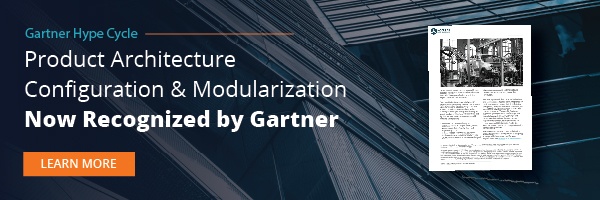Gartner’s recent 2022 Hype Cycle™ for Manufacturing Digital Transformation and Innovation recognized Product Architecture Configuration for the first time as an emerging technology to watch. But what is Product Architecture Configuration, why does it matter, and how does it impact global manufacturing in the future?
We recently had the opportunity to chat with Fredrik Erbing, Executive Vice President at Modular Management, to discuss these topics further. Organizations already employing Product Architecture Configuration or those looking to leverage this technology will find our discussion insightful. Enjoy!
Q: What is Product Architecture Configuration?
A: Product Architecture Configuration (PAC) is the centralized management of a product architecture with integrated configuration rules. Companies applying PAC are much more efficient in needs-based product configuration and the creation of technically feasible, saleable, and serviceable products. Requirements across all involved business processes throughout the product lifecycle are considered. A configurable product platform is much more than a box of unsorted Lego bricks, with PAC we document the needed product structure, as well as technical, business, and operation logic.
Q: Why is there a need for Product Architecture Configuration?
A: All companies strive to improve their relevance for customers, owners, and society. By applying PAC, goals for product leadership, operational excellence, and customer intimacy can be more easily fulfilled. New technology can be more quickly phased into products with additional variants available to customers. All whilst processes and supply chains are optimized, and profitability increases. Information management is the key enabler to this success and luckily, the solutions on the market are now better tailored for this way of working. As with all movements—change takes time.
Another driver is also the complexity of today’s and tomorrow’s products. Products are composed of mechanical, electronic, and software components. Life cycles are shorter. This drives complexity. And complexity needs to be managed efficiently.
Q: But doesn’t Gartner say this is an innovation with 5-10 years for maturity?
A: Yes, some companies have been successful in this way of working. Up to now, managing PACs has been a manual process for one or more individuals with an excel sheet. To scale and keep pace with future demand, it requires methods and solutions tailored for managing complex products.
Q: What is the significance of Gartner including Product Architecture Configuration in this Hype Cycle report?
A: Gartner is one of the leading researchers in the industry. When they decide to publish it’s a sign that change has already begun. The technology may evolve from Gartner’s initial predictions over time, but regardless organizations will be impacted in some way or another.
Q: What are the requirements for Modular Management to be relevant as a sample vendor?
A: Modular Management partners with companies to build the capabilities for creating and maintaining configurable product platforms. The learnings from over 25 years of advisory and software experience are well recognized by our customers and research institutions. Our collective knowledge is built around methods and tools to transform and grow our customers’ way of working. PALMA is acknowledged as the premier software solution for PAC.
Q: What is PALMA?
A: PALMA is the leading software solution for strategic and data-driven product management. PALMA enables full control over the lifecycle of your modular product platforms while also efficiently managing configurations.
PALMA is purpose-built to:
- Create and govern the best possible product platforms/architecture that serves customer needs and company execution
- Manage product portfolios of highly configurable products
- Facilitate collaboration by a unified information model that enables synchronization of product data across IT system landscapes
Q: PLM, CPQ, CRM, and now Product Architecture Configuration. How do they relate to each other?
A: All solutions have a purpose and core capability. Everyone wants to be the master and functionality evolves over time. PLM systems are for parts management, CPQ systems are for sales order management, CRM systems are for customer management, etc. PALMA’s core is configurable product management where PAC is the key capability.
Q: How does its inclusion impact the solution providers?
A: All solution providers want to be seen as a priority. Recognizing PAC in the Hype Cycle will impact solution providers and responses will come. Modular Management welcomes this activity as it will help all customers to improve.
Q: How do you see the technology evolving in the next decade?
A: Composable technology will be the key. Information models will be the enabler to share data across business applications and operationalize the digital thread or fabric. Business Leaders who understand that configurable product platforms are fundamental to business success will embrace Product Architecture Configuration.
Want to know more?
To learn more about the Gartner Hype Cycle and why including Product Architecture Configuration matters, download our 2022 Hype Cycle summary. Additionally, feel free to message me using the contact information below.
 AUTHOR
AUTHOR
Fredrik Erbing
Executive Vice President at Modular Management
fredrik.erbing@modularmanagement.com



